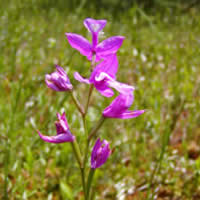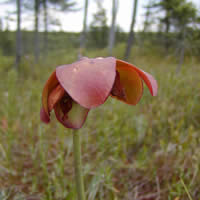USDA Forest Service Celebrating Wildflowers
|
|
|
Eastern Region Viewing AreaLOCATION and PHOTOS
Namekagon FenForest: Chequamegon-Nicolet National Forest District: Great Divide Ranger District Description: Namekagon Fen is a small, undisturbed, high quality open bog/sedge meadow community with a rich flora of sphagnum mosses, ericaceous shrubs, sedges, and insectivorous plants. Nested within the fen are a number of bog pools that support an extremely diverse flora typical of bogs with a higher pH value and a ground water influence. The fen is surrounded by a mixed forest of red oak (Quercus rubra), sugar maple (Acer saccharum), yellow birch (Betula alleghaniensis), and scattered white pine (Pinus strobus). The flora of the fen is dominated by white beak rush (Rhynchospora alba) and high numbers of purple pitcher plant (Sarracenia purpurea). Also, starting in late June and progressing into early July, Namekagon Fen is blanketed with the soft pink and white colors of grass pink (Calopogon tuberosus var. tuberosus) and rose pogonia (Pogonia ophioglossoides) orchids as well as the bright yellow of horned bladderwort (Utricularia cornuta). Other plants that occur are the few-seeded sedge (Cares oligosperma), cotton-grass (Eriophorum spp.), water bulrush (Schoenoplectus subterminalis), sundews (Drosera spp.), northern St. John’s wort (Hypericum boreale), bog buckbean (Menyanthes trifoliate), water shield (Brasenia schreberi), and rattlesnake manna grass (Glyceria canadensis). Ericaceous species such as bog-laurel (Kalmia polifolia), bog rosemary (Andromeda glaucophylla), leatherleaf (Chamaedaphne calyculata), and blueberry (Vaccinium spp.) are common as well. Small clumps of tamarack (Larix laricina) and black spruce (Picea mariana) are scattered throughout the site. Birds that are found at Namekagon fen include the common yellowthroat (Geothlypis trichas), and olive-sided flycatcher (Contopus cooperi). Safety First: This is a bog/wetland system. Bug spray is recommended. Foot attire appropriate for walking over rough and wet terrain is also recommended. The weather may be cool and rainy in the Spring or Fall; appropriate thermal and moisture protection is recommended. Directions: The site is located 9 miles east of Cable, Wisconsin. From Cable, go east on County M approximately 9 miles, then go south on FR 203 0.5 miles for access to the west side of the site. The east side of the site is easily accessed by FR 200. Ownership and Management: U.S. Forest Service, Chequamegon-Nicolet National Forest. Contact the Great Divide Ranger District at (715) 264-2511 for maps and travel conditions. Closest Town: Cable, Wisconsin. For More Information: |
|
| NOTE: PDF format links require the Adobe Acrobat Reader to view. | |
| top | Disclaimers | FOIA | Privacy Policy | Quality of Information | Photo Credits & Use |
Location: http://www.fs.fed.us/wildflowers/regions/eastern/Namekagon/index.shtml
Last modified: Tuesday, 24-Jun-2008 21:55:53 EDT




